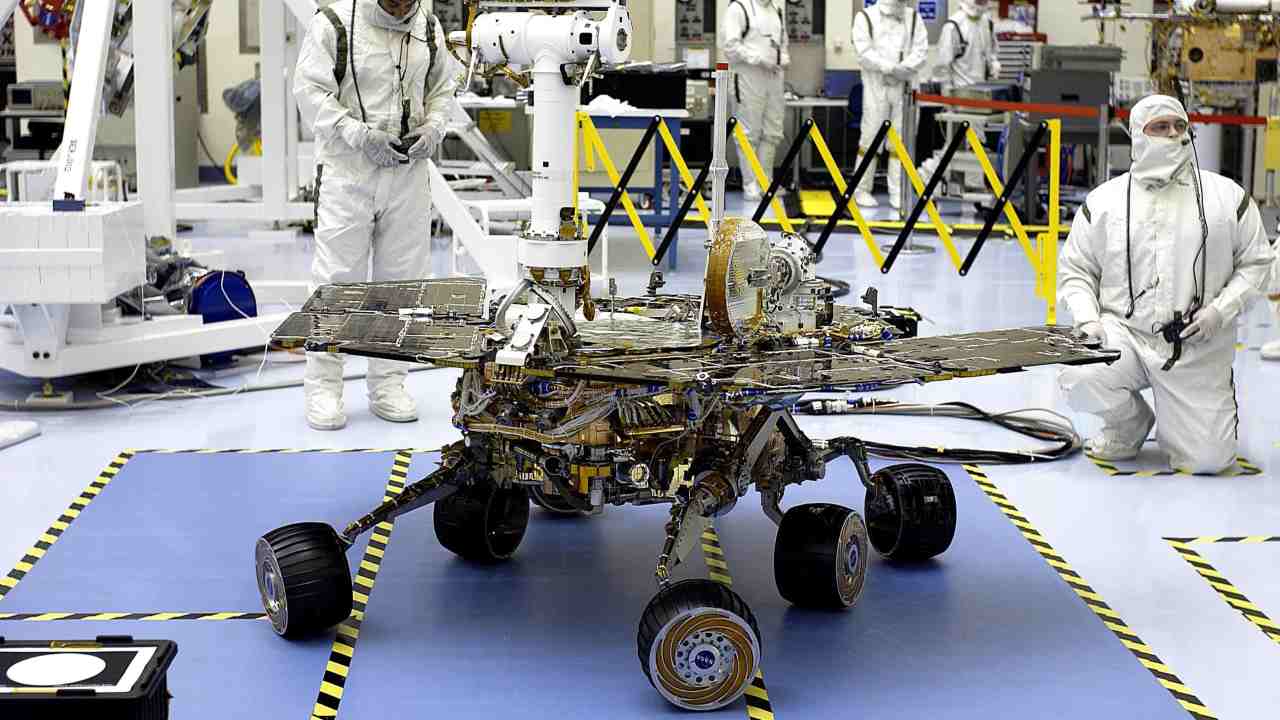In the last summer on Mars around June 2018, a dust storm swept over the surface for weeks and blocked out the sunlight. It enveloped all of Mars in dust, and marked the
last time that NASA made contact
with its Opportunity rover. The Martian storm that started it all The 15-year-old rover was likely covered in dust and cut off from solar power for days at a stretch. NASA decided to power the rover down to avoid any lasting damage to its panels or instruments. The rover was running in low-power mode - just enough to keep its heaters on and protect its innards from the biting cold temperatures at night. Once the storm cleared, Oppy could use sunlight to recharge its batteries and get back to being cent-per-cent. But things
clearly didn’t go down that way
, did they? [caption id=“attachment_5998561” align=“alignnone” width=“1280”] In a facility at the Kennedy Space Center, engineers and scientists test the Mars Exploration Rover-B, also known as Opportunity, for mobility and maneuverability on March 2003. Image credit: NASA[/caption] Why did Oppy lose contact? There are many different theories about what went sideways - solar panels caked with dust, something vital breaking with the dust storm’s intensity, a snapped communication link in the rover. NASA’s best guess is that the problem is in Oppy’s communication radio hardware and internet clock, which is critical for the rover’s “computer brain” to work okay. A series of unlikely events would need to have transpired for any one of these faults to occur, NASA shared in a recent
statement
. “Over the past seven months we have
attempted to contact Opportunity
over 600 times,” John Callas, project manager for Opportunity at JPL, said in the statement. “While we have not heard back from the rover, and the probability that we ever will is decreasing each day, we plan to continue to pursue every logical solution that could put us back in touch.” [caption id=“attachment_5378481” align=“alignnone” width=“1280”]
In a facility at the Kennedy Space Center, engineers and scientists test the Mars Exploration Rover-B, also known as Opportunity, for mobility and maneuverability on March 2003. Image credit: NASA[/caption] Why did Oppy lose contact? There are many different theories about what went sideways - solar panels caked with dust, something vital breaking with the dust storm’s intensity, a snapped communication link in the rover. NASA’s best guess is that the problem is in Oppy’s communication radio hardware and internet clock, which is critical for the rover’s “computer brain” to work okay. A series of unlikely events would need to have transpired for any one of these faults to occur, NASA shared in a recent
statement
. “Over the past seven months we have
attempted to contact Opportunity
over 600 times,” John Callas, project manager for Opportunity at JPL, said in the statement. “While we have not heard back from the rover, and the probability that we ever will is decreasing each day, we plan to continue to pursue every logical solution that could put us back in touch.” [caption id=“attachment_5378481” align=“alignnone” width=“1280”] Dust Clearing Season on Mars. Image: NASA[/caption] Before the do-or-die Martian winter arrives Unfortunately, these efforts need to happen soon - real soon. Mars is currently in the midst of the windiest seasons in the year, the dust-clearing season. Soon as this period comes to an end, the Martian winter will take over and bring temperatures as low as -100 degrees Celsius. This is bad news for the internal circuitry and batteries, which will see catastrophic damage from the frigid Martian lows. NASA is currently trying a new approach - potentially one last time - to get Oppy to respond. “The potential remedies being beamed up to address these unlikely events include a command for the rover to switch to its backup X-band radio and commands to reset its clock and respond via its UHF [ultra high frequency] radio,” the Oppy team at JPL said in the statement. [caption id=“attachment_5267121” align=“alignnone” width=“1280”]
Dust Clearing Season on Mars. Image: NASA[/caption] Before the do-or-die Martian winter arrives Unfortunately, these efforts need to happen soon - real soon. Mars is currently in the midst of the windiest seasons in the year, the dust-clearing season. Soon as this period comes to an end, the Martian winter will take over and bring temperatures as low as -100 degrees Celsius. This is bad news for the internal circuitry and batteries, which will see catastrophic damage from the frigid Martian lows. NASA is currently trying a new approach - potentially one last time - to get Oppy to respond. “The potential remedies being beamed up to address these unlikely events include a command for the rover to switch to its backup X-band radio and commands to reset its clock and respond via its UHF [ultra high frequency] radio,” the Oppy team at JPL said in the statement. [caption id=“attachment_5267121” align=“alignnone” width=“1280”] NASA’s Opportunity rover appears as a blip in the center of the image taken by a high-resolution camera on the Mars Orbiter after the dust storm had substantially cleared. Image courtesy NASA/JPL[/caption] One last time? The latest attempt to resuscitate the rover is in combination with an ongoing effort to “sweep and beep”, where the team beams command to the rover hoping it responds with a “beep.” So far, NASA has only listened to the rover. NASA has already lost one of its rovers to the Martian winter - the Spirit Rover back in 2010. However, even if Opportunity bites the (Martian) dust over the winter, its mission will be one of NASA’s most successful. Opportunity has outlived its original 90-day mission, and gone on for 14 years. This is largely thanks to Mars’ winds clearing the rover’s solar panels every year, allowing it to recharge. An unexpected boon for NASA, Oppy survived 55 times the lifespan it was built for. Whether Oppy makes it or doesn’t, the rover has done more than anyone anticipated for Mars exploration.
NASA’s Opportunity rover appears as a blip in the center of the image taken by a high-resolution camera on the Mars Orbiter after the dust storm had substantially cleared. Image courtesy NASA/JPL[/caption] One last time? The latest attempt to resuscitate the rover is in combination with an ongoing effort to “sweep and beep”, where the team beams command to the rover hoping it responds with a “beep.” So far, NASA has only listened to the rover. NASA has already lost one of its rovers to the Martian winter - the Spirit Rover back in 2010. However, even if Opportunity bites the (Martian) dust over the winter, its mission will be one of NASA’s most successful. Opportunity has outlived its original 90-day mission, and gone on for 14 years. This is largely thanks to Mars’ winds clearing the rover’s solar panels every year, allowing it to recharge. An unexpected boon for NASA, Oppy survived 55 times the lifespan it was built for. Whether Oppy makes it or doesn’t, the rover has done more than anyone anticipated for Mars exploration.
NASA tries to reach Opportunity rover one last time before Martian winter sets in
tech2 News Staff
• January 31, 2019, 13:57:17 IST
With winter on Mars weeks away, NASA is trying to reach Opportunity for what might be one last time.
Advertisement
)
End of Article